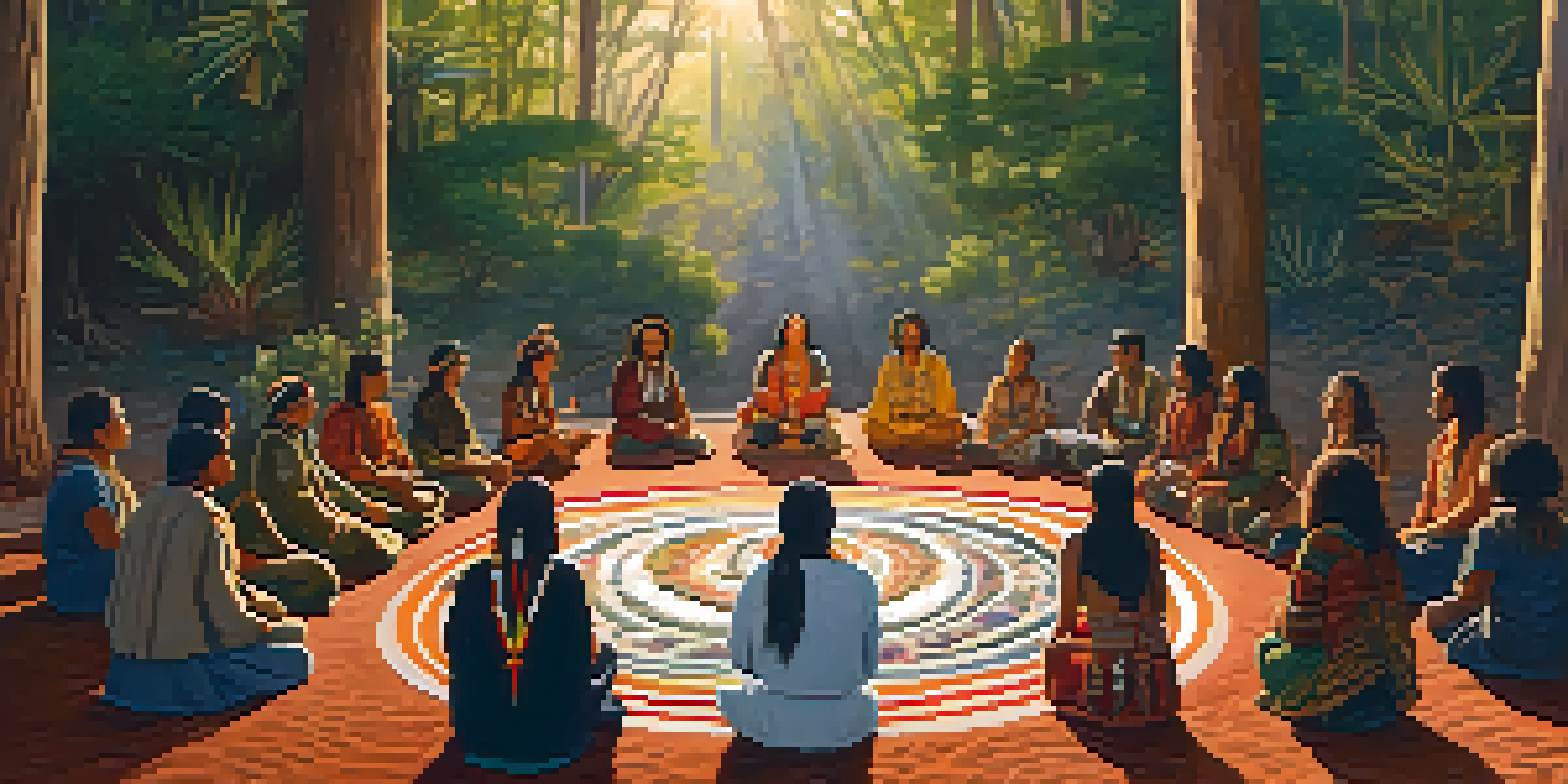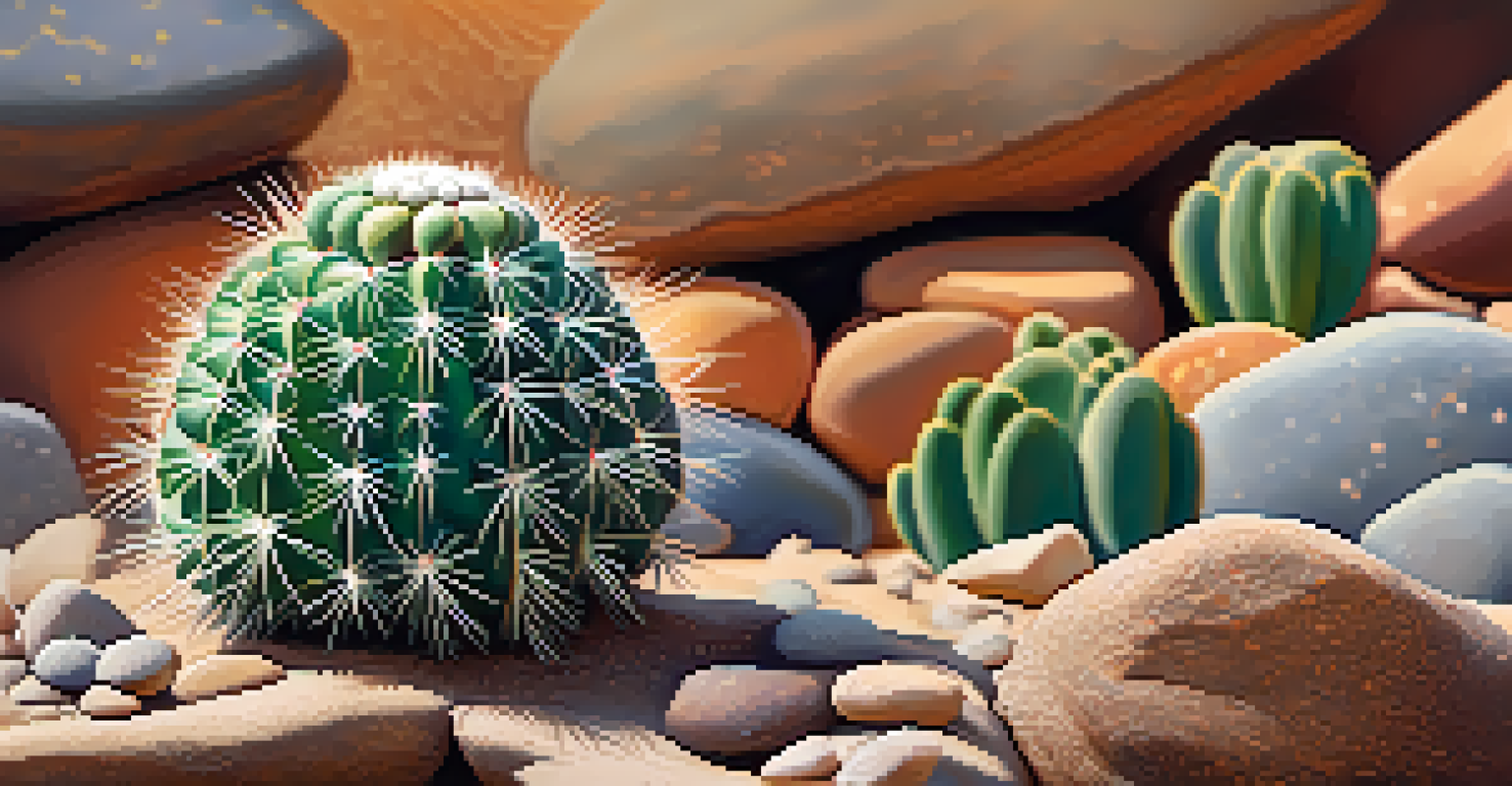Symbolism in Peyote Rituals: A Deep Dive into Meaning

Understanding Peyote in Indigenous Cultures
Peyote, a small cactus native to Mexico and the southwestern United States, holds significant cultural importance among various Indigenous peoples. For many tribes, it is more than just a plant; it serves as a spiritual guide and a bridge to the divine. The ritual use of peyote is deeply intertwined with their identity and traditions, offering a unique lens through which they understand their place in the world.
The plant is a sacred gift, a means to connect with the spirit world.
For instance, the Huichol people view peyote as a sacred gift from their deities, a means to connect with the spirit world. This connection is not merely about consumption; it’s a profound journey that encompasses prayer, songs, and communal bonding. Through these rituals, participants seek healing, guidance, and a deeper understanding of their lives and the universe around them.
Ultimately, peyote rituals encapsulate the essence of Indigenous spirituality, showcasing how nature and culture intersect. This relationship prompts individuals to reflect on their existence and the larger narrative of life, emphasizing the significance of symbolism in these practices.
The Role of Symbolism in Peyote Rituals
Symbolism plays a crucial role in peyote rituals, enriching the experience and providing layers of meaning. Each element, from the peyote itself to the accompanying songs and prayers, is imbued with symbolism that resonates with the participants. This symbolism serves as a guide, helping individuals navigate their spiritual journeys during the ritual.

For example, the circular shape of the peyote represents wholeness and unity, mirroring the cyclical nature of life. This idea of interconnectedness extends beyond the ritual itself, reminding participants of their place within their community and the natural world. As they consume peyote, they engage with these symbols, fostering a deeper connection to their identity and heritage.
Peyote's Cultural Significance
Peyote serves as a spiritual guide and essential element of identity for Indigenous peoples, highlighting its deep cultural importance.
In this way, symbolism acts as a translator between the physical and spiritual realms, enabling participants to grasp complex concepts and emotions. The rich tapestry of symbols within these rituals ultimately allows for personal interpretation, making each experience unique yet universally significant.
Ritual Elements: Symbols in Action
In peyote rituals, various elements come together to create a harmonious experience rich with symbolism. The setting, often a sacred space, is meticulously prepared to invite spiritual energies. Items such as feathers, stones, and drums are not mere props; they carry profound meanings that enhance the ritual's depth.
Symbolism is the language of the soul, allowing us to navigate our spiritual journeys.
For instance, feathers may symbolize connection to the spirit world, representing freedom and ascension. Drumming, on the other hand, serves to synchronize participants' energies, creating a communal heartbeat that amplifies the experience. Each of these elements works in concert, weaving a narrative that reinforces their cultural and spiritual beliefs.
As participants engage with these symbols, they find themselves drawn into a collective consciousness that transcends the individual. This sense of unity is vital, as it underscores the idea that their spiritual journeys are not solitary; rather, they are part of a larger community narrative that has been passed down through generations.
Personal Transformation Through Peyote
One of the most significant aspects of peyote rituals is their potential for personal transformation. Participants often report profound insights and revelations during their experiences, facilitated by the symbolic meanings surrounding them. This transformative journey can lead to healing, self-discovery, and a renewed sense of purpose.
For many, the ritual becomes a mirror reflecting their inner struggles and aspirations. The symbolism of the peyote cactus, with its ability to grow in harsh conditions, serves as a reminder of resilience and hope. As individuals navigate their personal challenges, they find strength in the communal support and the shared symbolism of their ancestors.
Symbolism Enhances Rituals
The rich symbolism embedded in peyote rituals fosters personal interpretation and connection among participants, enriching their spiritual journeys.
Ultimately, this journey of transformation is not just about the individual; it's a collective awakening. The insights gained during these rituals can ripple outwards, affecting families and communities, as participants return with newfound clarity and understanding, enriching the fabric of their cultural heritage.
Healing and Symbolism in Peyote Practices
Healing, both physical and spiritual, is a core component of peyote rituals, with symbolism playing a vital role in this process. Many participants seek peyote for its therapeutic effects, hoping to address ailments that modern medicine may not fully resolve. The ritual's symbolic elements create a safe space for healing, allowing individuals to confront their pain and traumas.
The act of consuming peyote can symbolize a journey into oneself, where participants can explore their emotions and experiences in a supportive environment. The communal aspect of the ritual enhances this healing process, as participants share their stories and support one another. This shared vulnerability fosters an atmosphere of trust and understanding, crucial for effective healing.
Moreover, the symbolism associated with healing extends beyond the individual. The community's collective energy during the ritual amplifies the healing potential, suggesting that true wellness encompasses both personal and communal aspects. This interconnected approach to healing underscores the significance of symbolism in peyote rituals.
Challenges and Misunderstandings of Peyote Rituals
Despite the rich symbolism and cultural significance of peyote rituals, they face numerous challenges and misunderstandings. Many people outside Indigenous cultures may view these practices through a narrow lens, often reducing them to mere drug use. This misconception overlooks the profound spiritual and communal aspects that define peyote rituals.
Furthermore, the commercialization of peyote and its symbolism can be harmful. When rituals are appropriated or commodified, the deep cultural meanings can be diluted, leading to a loss of authenticity. This not only disrespects Indigenous traditions but also diminishes the transformative power that these rituals hold for their communities.
Healing Through Community Rituals
Peyote rituals facilitate healing both individually and collectively, emphasizing the interconnectedness of personal and communal wellness.
Addressing these challenges requires education and awareness about the true nature of peyote rituals. By fostering understanding and respect for the symbolism and cultural context, we can appreciate these practices for their depth and significance, ensuring that they continue to thrive within their rightful cultural framework.
Conclusion: Embracing the Symbolism of Peyote Rituals
In conclusion, the symbolism found in peyote rituals is a rich tapestry woven from culture, spirituality, and personal experience. These rituals serve as a powerful reminder of the interconnectedness of life and the profound meanings that can emerge from our connections to nature and each other. By understanding and respecting these symbols, we can deepen our appreciation for Indigenous cultures and their sacred practices.
As we reflect on the role of symbolism in peyote rituals, we are encouraged to recognize the importance of these practices in fostering healing, transformation, and communal bonds. This understanding invites us to approach these rituals with an open heart and mind, appreciating the wisdom they offer.

Ultimately, embracing the symbolism of peyote rituals allows us to participate in a larger conversation about identity, spirituality, and the human experience. It reminds us that, while our journeys may differ, the quest for meaning and connection is a universal endeavor.